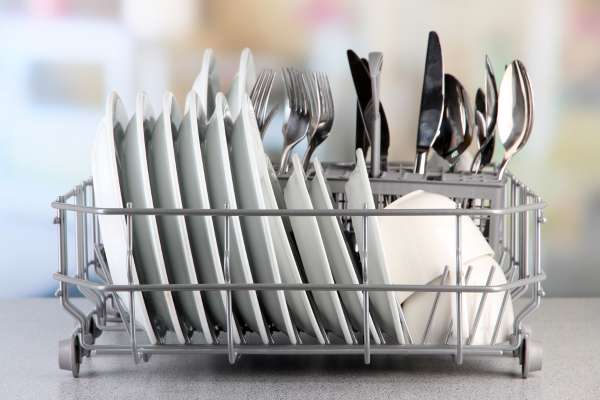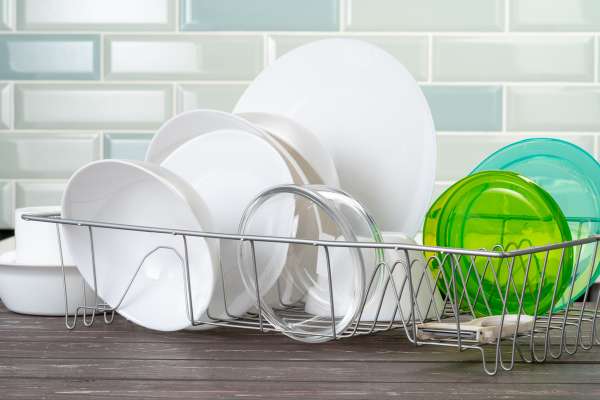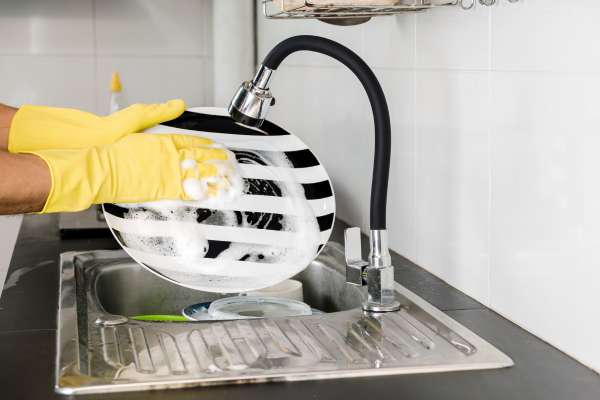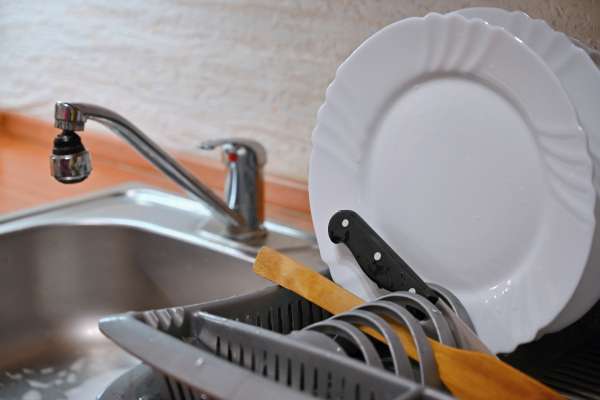Maintaining cleanliness in the kitchen involves more than just washing dishes And wiping down counters it also includes taking care of the tools we use in the process, One of which is the dish racks. Over time, dish racks can collect grime, food particles, and even develop mold due to the moist environment they exist in. Regular cleaning ensures that your dishes stay As clean And hygienic as possible. Not only does A clean dish rack contribute to A healthier kitchen, but it also extends the life of the rack itself. In this guide, we’ll be walking you through a simple process on how to clean your dish rack effectively.
Why Is It Important To Clean Your Dish Rack?

Cleaning your dish rack is crucial not only for maintaining a sanitary kitchen environment but also for the durability and aesthetics of the rack itself. Due to constant exposure to moisture and food particles, dish racks can become breeding grounds for mold, bacteria, And mildew, which could contaminate your dishes and utensils, thereby posing A potential health risk.
Moreover, accumulated grime can expedite the wear and tear of the rack, and in the case of metal ones, even lead to rust. Regular cleaning of your dish racks can thus enhance its longevity.
Additionally, a clean dishes rack adds to the overall cleanliness and visual appeal of your kitchen, while a dirty one can detract from even the most immaculate surroundings. Lastly, regular cleaning prevents the build-up of trapped food particles and bacteria, which can cause unpleasant odors over time. In essence, cleaning your dish rack is a vital step in keeping your kitchen hygienic, fresh, and visually pleasing.
How To Clean Dish Rack: Step-By-Step Guide
1. Gathering The Necessary Supplies

The first step in the cleaning process is gathering All the necessary supplies. You will need dish soap, warm water, A soft cloth or sponge, A scrub brush for hard-to-reach areas, And a towel for drying. If your dishes rack has A significant amount of grime, Or it’s been A while since its last clean, you might also need white vinegar or baking soda as a natural disinfectant and deodorizer. Additionally, You may want to have A toothpick or skewer handy for removing any bits of food that have gotten lodged in small crevices.
2. Removing The Dish Rack From The Sink

Once you have all the supplies ready, The next step is to remove the dishes rack from the sink. Empty it completely, ensuring all dishes And utensils are removed. If your dishes racks has A drain board or a cutlery holder, make sure to remove those as well. This step will allow you to clean each part of the dish rack individually and more thoroughly.
3. Scrubbing Away Grime And Scale

Now, It’s time To start the actual cleaning process. Fill your sink or A large tub with warm water and add A good amount of dishes soap. Place your dishes racks in the soapy water And let it soak for a few minutes to loosen any grime or scale. After soaking, use your cloth or sponge to clean the rack, scrubbing all sides and corners. For harder-to-reach areas, or for stubborn grime, use your scrub brush or toothpick. If you’re using vinegar Or baking soda, now is the time To apply them. Once you’ve thoroughly cleaned the rack, rinse it under warm water to remove any soap or cleaning solution, And then dry it thoroughly with A towel to prevent the growth Of mold and mildew.
4. Cleaning The Drip Tray

The drip tray, Also known as A drain board, is often neglected in the cleaning process, But it’s important to clean it as it can harbor bacteria and grime. If your dish rack includes a drip tray, remove it and clean it separately. Soak it in the soapy water, Then scrub it well with your sponge or cloth, making sure to reach all corners And crevices. For any stubborn grime, use the scrub brush. Once it’s clean, rinse it thoroughly under warm water to remove soap residue.
5. Disinfecting The Dish Rack

After the dish racks and its components have been cleaned, it’s important to disinfect them to eliminate any remaining bacteria or mold. To do this, prepare a solution of one part white vinegar to three parts warm water. Soak your dishes racks and its components in this solution for about 10-15 minutes, then rinse them well. Vinegar is a natural disinfectant that can kill most germs without leaving a harmful residue.
6. Drying And Reassembling The Dish Rack

The final step in the cleaning process is drying and reassembling your dishes racks. It’s crucial to dry all parts of the dishes racks thoroughly to prevent the growth of mold and mildew. Use A dry towel to wipe down each part, Or allow them to air-dry completely. Once everything is dry, reassemble your dishes racks and it’s ready to be used again. Regularly maintaining your dishes racks in this way will ensure it remains clean, hygienic, And lasts for years to come.
How Often Should You Clean Your Dish Rack?
The frequency of cleaning your dish racks largely depends on its usage and the environment in which it’s placed. As a general rule of thumb, It’s good practice to clean your dishes rack thoroughly at least once A week. However, If your dish rack is heavily used Or is placed in a humid environment that could promote the growth of mold and bacteria, You might want to clean it more frequently, possibly every few days.
It’s also advisable to perform light cleaning daily. This includes emptying and shaking out any excess water, wiping it down to prevent standing water, and removing any visible food particles. Regular maintenance like this will help to keep your dishes racks in a good, hygienic condition between the more thorough weekly cleanings.
Tips To Prevent Dish Rack Buildup
- Daily Maintenance: To prevent the buildup of grime and bacteria, consider incorporating daily cleaning routines. Shake off excess water and wipe down your dishes racks after use, paying special attention to corners and crevices where water can pool and promote bacterial growth.
- Proper Dish Cleaning: Before placing dishes on the rack, make sure they are properly cleaned and free from food particles. Remnants of food on dishes can end up on the racks and cause buildup over time.
- Use a Drip Tray: A drip tray or drain board can help collect water that drips from the dishes, preventing it from staying on the racks and causing rust or mold. Remember to empty and clean the drip tray regularly.
- Adequate Ventilation: Make sure your dish racks are located in a well-ventilated area. Good air circulation can help to dry out the racks faster and prevent the growth of bacteria and mold.
- Regular Deep Cleaning: As discussed earlier, performing a thorough cleaning of your dishes racks weekly or bi-weekly can help prevent buildup. This includes scrubbing, disinfecting, and thoroughly drying the rack.
- Consider a Rack with Antimicrobial Features: Some modern dishes racks come with antimicrobial protection to inhibit the growth of bacteria. This can be an added line of defense, although it doesn’t replace the need for regular cleaning.
- Don’t Overload the Rack: Overloading the dish racks can trap moisture and create hidden, moist spots which are perfect breeding grounds for bacteria. Allow for ample space between items for air to circulate freely.
Following these tips can help you keep your dish racks in good condition, extend its lifespan, And maintain A hygienic kitchen environment.
Can I Use Vinegar To Clean My Dish Racks?
Absolutely, vinegar is an excellent natural cleaner and disinfectant that is well suited for cleaning a dish racks. Due to its acidity, vinegar can effectively kill most types Of mold, germs, And bacteria.
Here’s how you can use vinegar to clean your dish racks:
- Prepare the solution: Mix equal parts of white vinegar and warm water in a basin or your sink.
- Soak and scrub: Place your dish racks in the solution and let it soak for about 15-30 minutes. After soaking, use a sponge or scrub brush to clean all parts of the rack, paying extra attention to corners and hard-to-reach places.
- Rinse and dry: Once you’ve scrubbed the racks thoroughly, rinse it under warm water to remove any remaining vinegar solution. Be sure to dry it completely to prevent the growth of mold and mildew.
Vinegar can also be used as a preventive measure against mold and bacterial growth. Regularly spraying your dishes racks with a vinegar solution and letting it air dry can help keep it clean and sanitary.
It’s worth noting, however, That while vinegar is safe to use on most materials, It can damage some types of metal if left on for too long. Always rinse your racks thoroughly after cleaning it with vinegar, And make sure it’s dried properly.
The Final Thoughts
Learning how to clean a dish rack is an important part of maintaining kitchen hygiene and extending the lifespan of this essential tool. By gathering necessary cleaning supplies like dish soap, warm water, a soft cloth or sponge, and possibly vinegar or baking soda, you can thoroughly scrub and disinfect your dishes racks. Don’t forget to pay attention to all parts, including the often-neglected drip tray. After cleaning, ensure all components are thoroughly dried before reassembly to prevent mold and mildew growth. With consistent care, which includes daily maintenance and weekly deep cleaning, you’ll keep your dishes racks in top condition, contributing to a cleaner and healthier kitchen environment.
